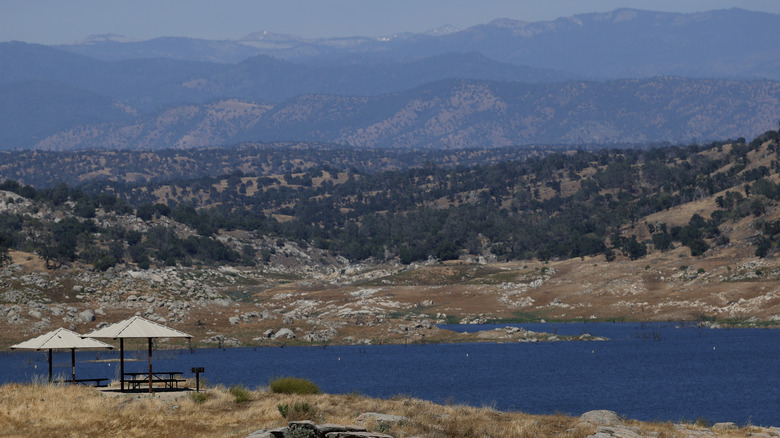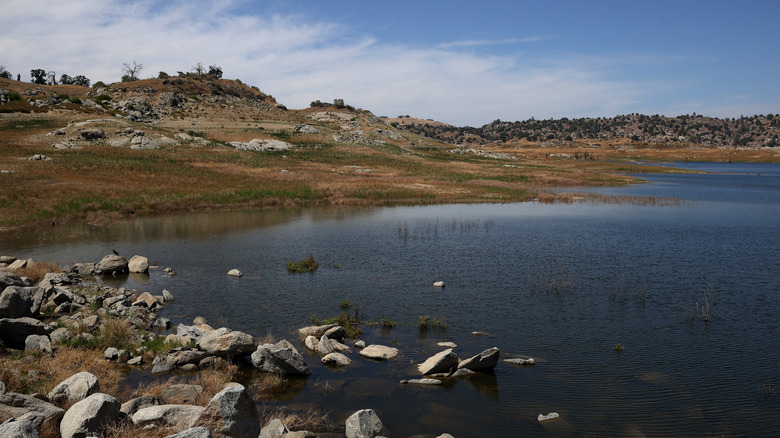Outside Fresno Is California's Community With Serene Lake Camping Near Yosemite National Park
This unincorporated California community is the OG gateway to Yosemite National Park. The once-bustling train depot of Raymond was a major transportation hub in its heyday, serving as the final stop on the Southern Pacific Railroad. From there, tourists were able to catch a stagecoach up to the sprawling wilderness area, which is only about an hour's drive to the southern entrance by car if you don't want to go it by horse.
Not much has changed in and around this rural nook of the state since its founding back in the late 1800s. Sure, the railway line is long gone, abandoned in the 1940s, and the main thoroughfare is now paved. But the deep-rooted character of the historic town, as well as some of its olden architectural relics, remains largely unchanged. Visitors can see a few original buildings, not to mention the beautiful backdrop of the Sierra Nevada, still standing tall today. "This town means the world to me," one local penned on Facebook. "There are hidden gems here in these hills and mountains ... Come visit and stay a while. You might just fall in love like we all have."
Raymond still makes for a great jumping-off point for those keen on exploring the national park. It's only about an hour north of the Fresno Yosemite International Airport (FAT) in Fresno — one of California's surprisingly affordable cities for retirees. Home to two lakes, the shores of which are lined with serene campgrounds, this Madera County gem won't likely disappoint.
Set up camp in Raymond, California
Raymond's two main reservoirs — Hensley Lake and Eastman Lake — are nestled right in the rolling foothills of the Sierra Nevada. Even better, they're both teeming with peaceful campsites, making them excellent base camps for roaming the Central Valley wilds. So be sure to pack up all your best camping gear for a quick and easy outdoor retreat because you're in for a real adventure.
At Eastman, which covers about 1,800 surface acres, you'll find the Codorniz Recreation Area Campground and Wildcat Campground. The latter doesn't have any electrical hookups, though, so if you need to power up any devices or RVs, opt to hunker down at Codorniz, which has far more amenities. Though both offer showers, fire pits, picnic areas, and wondrous nature views. "Loved the wildlife. Saw some wild turkeys, quail, and a doe," one campgoer shared online. Nightly rates for either campground range between $20 and $100 for the 2025 and 2026 seasons.
Hensley Lake is just a wee bit smaller, spanning roughly 1,500 surface acres. The reservoir has one campground, called Hidden View, which boasts more than 50 electric and non-electric campsites. "This is such a beautiful, hidden gem of a lake," reads one review. "I loved the quietness of the campground — no train or road noises in the night ... Clean bathrooms and a hot shower complemented my stay." It's important to note that both reservoirs' water levels can fluctuate greatly. So if you plan on diving into any watersports, be sure to check the status of the lakes before heading over.
Round out your itinerary
Once you're ready to stretch your legs, lace up your hiking boots and roam the great outdoors. If Yosemite's most notoriously difficult trails seem a bit daunting, there are plenty of scenic paths around the Hensley and Eastman Lakes that are doable for all skill levels.
The Shaw Shuck Trail is an easy, almost half-mile jaunt that loops through the scenery on the western bank of the Hensley reservoir near the Hidden View Campground. You can also get your steps in at the Buck Ridge Day Use Area, on the eastern side of the lake. For more of a challenge, tackle the Lakeview Trail at Eastman, which snakes its way along the shoreline roughly 8 miles, round-trip.
If you'd prefer to step back in time, venture over to the Raymond Museum. It's only open on Sundays from noon to 4 p.m., at the time of writing, but it does showcase some rather remarkable historical treasures about the Old West. The museum is housed in Raymond's very first homestead, an 1880s-era rustic abode known as the Charles Miller House. The grounds also feature a red caboose and other remnants of the Southern Pacific, such as the raised trackbed from long ago. "Don't drive past this one," reads one Google review. "Such a cool spot with so much history!"


